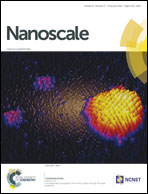Bandgap engineering of colloidal zinc oxysulfide via lattice substitution with sulfur†
Abstract
Zinc oxysulfide nanocrystals with zinc blende phase are synthesized through a wet-chemical method. An affirmation of the crystal structure, elemental homogeneity and phase transformation is obtained by X-ray diffraction and authenticated by electron micrographic studies. Theoretical observations have strongly supported the thermodynamic solubility limit for its (30%) formation. An anomalous bandgap bowing with modulation in bandgap from 3.74 eV (ZnO) to 3.93 eV (ZnS) was observed with a minimum bandgap of 2.7 eV. Tunable bandgap and a wide range of visible emission ascertain it as a potential material for optoelectronic and solar cell applications due to its large bandgap offsets.


 Please wait while we load your content...
Please wait while we load your content...